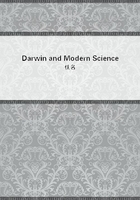
第180章
It looks as if it had required almost ten years for "The Origin of Species"to show its full effect, since the year 1868 marks the publication of Haeckel's "Naturliche Schoepfungsgeschichte" in addition to other great works. The terms "Oecology" (the relation of organisms to their environment) and "Chorology" (their distribution in space) had been given us in his "Generelle Morphologie" in 1866. The fourteenth chapter of the "History of Creation" is devoted to the distribution of organisms, their chorology, with the emphatic assertion that "not until Darwin can chorology be spoken of as a separate science, since he supplied the acting causes for the elucidation of the hitherto accumulated mass of facts." A map (a "hypothetical sketch") shows the monophyletic origin and the routes of distribution of Man.
Natural Selection may be all-mighty, all-sufficient, but it requires time, so much that the countless aeons required for the evolution of the present fauna were soon felt to be one of the most serious drawbacks of the theory.
Therefore every help to ease and shorten this process should have been welcomed. In 1868 M. Wagner (The first to formulate clearly the fundamental idea of a theory of migration and its importance in the origin of new species was L. von Buch, who in his "Physikalische Beschreibung der Canarischen Inseln", written in 1825, wrote as follows: "Upon the continents the individuals of the genera by spreading far, form, through differences of the locality, food and soil, varieties which finally become constant as new species, since owing to the distances they could never be crossed with other varieties and thus be brought back to the main type.
Next they may again, perhaps upon different roads, return to the old home where they find the old type likewise changed, both having become so different that they can interbreed no longer. Not so upon islands, where the individuals shut up in narrow valleys or within narrow districts, can always meet one another and thereby destroy every new attempt towards the fixing of a new variety." Clearly von Buch explains here why island types remain fixed, and why these types themselves have become so different from their continental congeners.--Actually von Buch is aware of a most important point, the difference in the process of development which exists between a new species b, which is the result of an ancestral species a having itself changed into b and thereby vanished itself, and a new species c which arose through separation out of the same ancestral a, which itself persists as such unaltered. Von Buch's prophetic view seems to have escaped Lyell's and even Wagner's notice.) came to the rescue with his "Darwin'sche Theorie und das Migrations-Gesetz der Organismen". (Leipzig, 1868.) He shows that migration, i.e. change of locality, implies new environmental conditions (never mind whether these be new stimuli to variation, or only acting as their selectors or censors), and moreover secures separation from the original stock and thus eliminates or lessens the reactionary dangers of panmixia. Darwin accepted Wagner's theory as "advantageous." Through the heated polemics of the more ardent selectionists Wagner's theory came to grow into an alternative instead of a help to the theory of selectional evolution. Separation is now rightly considered a most important factor by modern students of geographical distribution.
For the same year, 1868, we have to mention Huxley, whose Arctogaea and Notogaea are nothing less than the reconstructed main masses of land of the Mesozoic period. Beyond doubt the configuration of land at that remote period has left recognisable traces in the present continents, but whether they can account for the distribution of such a much later group as the Gallinaceous birds is more than questionable. In any case he took for his text a large natural group of birds, cosmopolitan as a whole, but with a striking distribution. The Peristeropodes, or pigeon-footed division, are restricted to the Australian and Neotropical regions, in distinction to the Alectoropodes (with the hallux inserted at a level above the front toes)which inhabit the whole of the Arctogaea, only a few members having spread into the South World. Further, as Asia alone has its Pheasants and allies, so is Africa characterised by its Guinea-fowls and relations, America has the Turkey as an endemic genus, and the Grouse tribe in a wider sense has its centre in the holarctic region: a splendid object lesson of descent, world-wide spreading and subsequent differentiation. Huxley, by the way, was the first--at least in private talk--to state that it will be for the morphologist, the well-trained anatomist, to give the casting vote in questions of geographical distribution, since he alone can determine whether we have to deal with homologous, or analogous, convergent, representative forms.
It seems late to introduce Wallace's name in 1876, the year of the publication of his standard work. ("The Geographical Distribution of Animals", 2 vols. London, 1876.) We cannot do better than quote the author's own words, expressing the hope that his "book should bear a similar relation to the eleventh and twelfth chapters of the "Origin of Species" as Darwin's "Animals and Plants under Domestication" does to the first chapter of that work," and to add that he has amply succeeded.